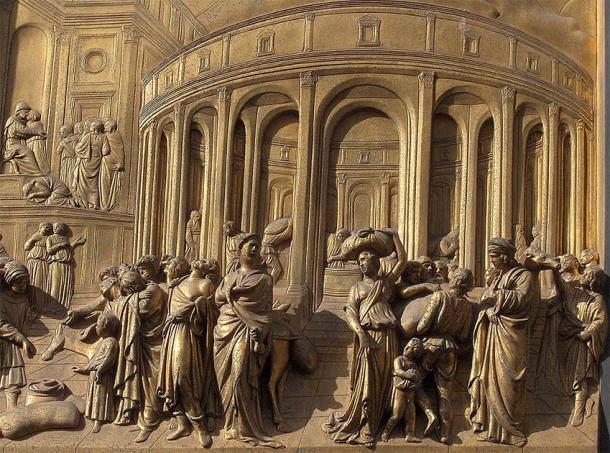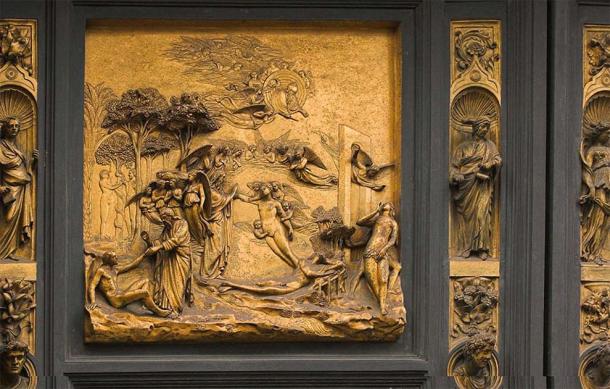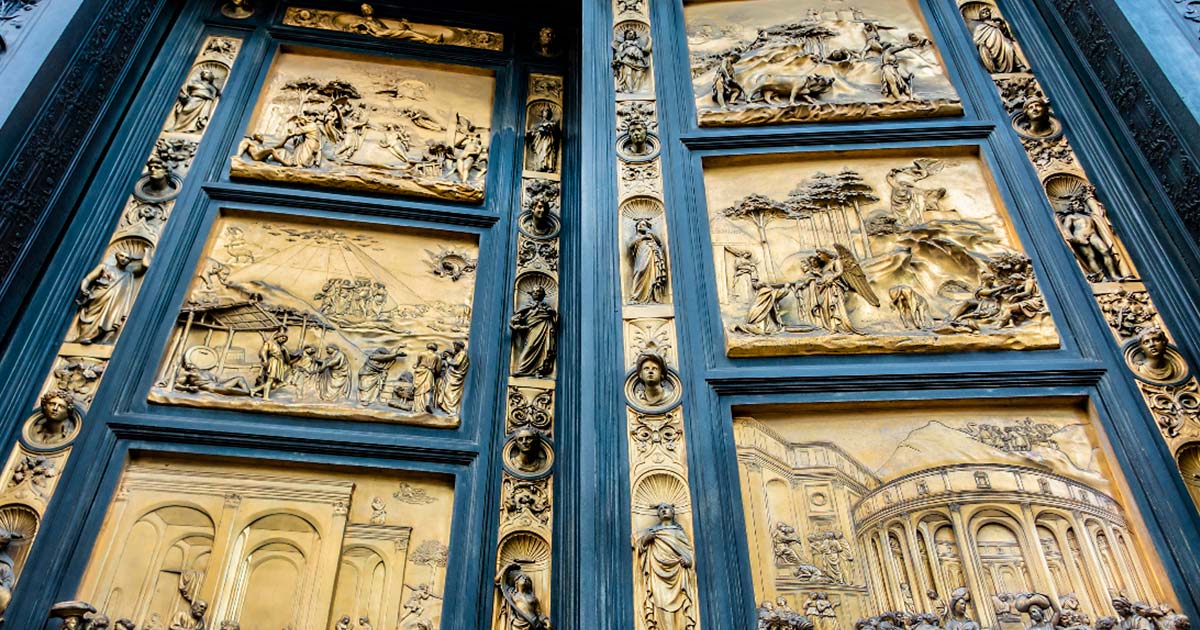The Gates of Paradise in Florence - A Masterpiece of Renaissance Art
Florence, called by many the cradle of the Renaissance, is home to many architectural masterpieces that embody the artistic and intellectual glory of that era. Among these treasures, one stands out as a symbol of beauty, craftsmanship, and spiritual significance: the Gates of Paradise. These magnificent bronze doors, located on the eastern facade of the Florence Baptistery, are not mere portals but rather a breathtaking representation of divine splendor. Rich, extravagant, and awe-inspiring, these lavish doors stand as a testament of the extraordinary craftsmanship of Renaissance masters - a craftsmanship that may never again be matched.
Born of a Young Sculptor’s Hand: The Origins of the Gates of Paradise
To truly appreciate the Gates of Paradise, one must understand the historical and cultural context in which they were created. The doors were chosen to adorn the famed Florence Baptistery. Also known as the Baptistery of Saint John ( Battistero di San Giovanni), it is one of the oldest and most important religious buildings in Florence, Italy. Located in the Piazza del Duomo, adjacent to the Florence Cathedral (Duomo), it holds great historical, architectural, and cultural significance. The origins of the Florence Baptistery can be traced back to the 4th century when it was built on the remains of a Roman temple. The original structure was a small octagonal building dedicated to Saint John the Baptist. Over the centuries, the Baptistery underwent several expansions and renovations, resulting in the magnificent structure we see today.
The Baptistery showcases a blend of architectural styles, including Romanesque and Gothic influences. Of course, it is most renowned for housing three sets of impressive bronze doors, each of which represents different artistic periods. The most famous of these are, of course, the Gates of Paradise by Lorenzo Ghiberti. The other two sets are the South Doors by Andrea Pisano and the North Doors, also known as the Doors of the Florence Baptistery, which were also completed by Ghiberti. For centuries, the Florence Baptistery was no more than a religious center in the town. It wasn’t until Ghiberti was commissioned to create the doors that the Baptistery's artistic grandeur would be elevated to unprecedented heights.

Gates of Paradise, Self-portrait bust of Lorenzo Ghiberti (early 15th century). (Richardfabi/CC BY-SA 3.0)
The Artist Destined for Grandeur
Lorenzo Ghiberti (1378-1455) was born in Florence, and apprenticed under his own father, Bartoluccio Ghiberti, a noted goldsmith. Under this guidance, Lorenzo learned the challenging art of metalwork and sculpture. What is more, he also received a classical education, which influenced his later artistic style. The boy showed talent from the get-go, and was on his way to surpass the mastery of his father. Such was his talent that he didn’t shy away from attempting great feats - which would immortalize his name in history.
He finally got his chance in 1401, when the influential Arte di Calimala guild announced a competition to design a set of bronze doors for the Baptistery. This competition aimed to find an artist capable of creating a masterpiece that would enhance the beauty and prestige of this venerable religious building. The guild’s announcement attracted numerous talented artists. Ghiberti, just 23 years old at the time and relatively unknown in the artistic circles, emerged as the winner, surpassing renowned artists such as Filippo Brunelleschi and Donatello. Such was the grandeur of his work. His submission showcased his skill in creating intricate relief work and his ability to incorporate elements of perspective and depth. It was an art piece never before seen. Today, this piece of work is known as the North Doors.

North doors by Lorenzo Ghiberti, Museo dell'Opera Del Duomo. (Lorenzo Ghiberti/CC BY 3.0)
Needless to say, Ghiberti's design impressed the judges. It stood out with its elegance, narrative quality, and overall mastery of bronze casting. Young Lorenzo was a decisive victor, and was soon showered with further commissions, even from the Pope himself. He was suddenly one of the foremost talents in Florence, and received recognition from everyone. In 1424, he received his second commission, this time for the East Doors of the Baptistery. He set about working on what was to become his lifetime achievement. And it took him 27 years to finish it!
The doors consisted of ten bronze panels, each depicting a different biblical scene or story, exquisitely crafted with incredible attention to detail. When finally revealed, the doors received immense praise, attracting visitors from across the region and further cementing Florence’s status as a true art capital. Their fame also made Ghiberti a very rich and popular figure in the city.

Florence Baptistery: East doors, or Gates of Paradise, by Lorenzo Ghiberti. The panels of the elaborate door to the Baptistery in Florence illustrate scenes from the Old Testament. One of the panels (left-hand-side, second from top) illustrates the life of Noah, in particular the period after the Great Flood when Noah returns to dry land with the help of God. Strangely, the Ark is depicted as a pyramid. (Lorenzo Ghiberti/CC BY 3.0)
Magnificent Depictions of Most Important Biblical Tales
The Gates of Paradise consist of ten panels that were intricately cast in bronze, each one richly adorned with biblical scenes and ornamental details. During his almost three-decade work, Ghiberti drew inspiration from classical antiquity and incorporated key elements of perspective and depth, breaking away from the medieval tradition of flat relief. The panels depict stories from the Old Testament, including Adam and Eve, Noah's Ark, The Giving of Law, Triumph of Joshua, Moses and the Burning Bush, the Parting of the Red Sea, and the Sacrifice of Isaac. The central, most poignant panel portrays the Baptism of Christ, surrounded by elaborate architectural frames and allegorical figures.

Gates of Paradise, The Story of Joseph. (Public Domain)
Of course, creating such a monumental masterpiece required a lot of work and the breaking of aged standards of the time. Ghiberti's work on the Gates of Paradise not only showcased his artistic genius but also marked a significant technological advancement in bronze casting. He perfected the complex lost-wax casting technique, allowing for greater precision and quite intricate detail. The complex relief work, delicate figures, and meticulous ornamentation all testify to the remarkable craftsmanship and technical skill of Ghiberti and his team of artisans. And, needless to say, as you admire the Gates of Paradise, it quickly becomes clear why their creation took an incredible 27 years!

Gates of Paradise, The Story of Adam and Eve (copy at the Baptistery). (After Lorenzo Ghiberti, CC BY-SA)
We should not be surprised that the actual theme of the Gates of Paradise is of a deeply religious nature. Of course, the first and foremost reason for this is because they adorn the Baptistery, an important religious building. Religion played a significant role in Renaissance Florence, as the Catholic Church wielded immense power and influence during this period. Florence, like other Italian city-states, was deeply connected to the Church, and the Pope held significant authority over political and religious matters. The Church's teachings, rituals, and sacraments were central to the daily lives of Florentines. This is why a lot of the art produced in the city had religious themes. The city's churches and religious institutions were adorned with magnificent sculptures, frescoes, and altarpieces, created by prominent artists of the time. Many patrons wanted to gain the favor of the church by commissioning these pieces, cementing their power and prestige in Florence.
- The Pazzi Conspiracy: How A Florentine Family Failed And Was Banished
- Religious Revolution: Unveiling the Protestant Reformation (Video)
An Art Piece to Stand the Test of Time
Over the centuries, the Gates of Paradise have faced numerous challenges, including weathering, pollution, and damage from wars. They were not entirely spared from the ravages of passing time. In the mid-20th century, due to concerns about their state and their preservation, the original panels were replaced with high-quality replicas. The originals were moved to the Museo dell ‘Opera del Duomo for restoration and safekeeping. After an extensive restoration process, the original panels were returned to the Baptistery in 2016, allowing visitors to witness their splendor firsthand. Thanks to the advancements of the modern age, we can rest assured that the restored panels will be much less vulnerable to the elements and pollution.
The Gates of Paradise exerted a profound influence on the Renaissance and subsequent artistic movements. Artists, architects, and intellectuals flocked to Florence to study Ghiberti's doors, considering them a prime example of beauty and proportion. The elegance and narrative power of the panels inspired generations of artists, including Michelangelo, who famously described them as "fit to be the Gates of Paradise”, as they have been called ever since. Their influence can be seen in various artworks and architectural elements throughout Florence and beyond.
Beyond their artistic and historical importance, the Gates of Paradise hold significant cultural and spiritual symbolism. As the entrance to the Baptistery, they serve as a threshold between the secular world and the sacred space of baptism. The doors represent a gateway to spiritual rebirth and the eternal realm, inviting believers to enter and partake in the sacrament. The intricate biblical scenes depicted on the panels serve as visual narratives that educate and inspire the faithful, reinforcing the religious significance of baptism and the teachings of Christianity.
- Da Vinci’s Deadly Designs: The Wildest Weapons of the Renaissance Man
- Origins of the Magnificent Florentine Cathedral Santa Maria di Fiore
A Renaissance Marvel That Still Attracts Visitors
Today, visitors to Florence have the opportunity to witness the awe-inspiring beauty of the Gates of Paradise firsthand, unchanged and unblemished. The Baptistery remains open to the public, allowing visitors to marvel at the intricate details, the interplay of light and shadow, and the masterful storytelling captured within the panels. The richness of the bronze, the delicate relief work, and the harmonious composition create a sensory experience that transcends time and connects visitors to the artistic genius of the Renaissance.

The altar, Inside the Baptistery in Florence, Italy. (Sailko/CC BY-SA 4.0)
The Gates of Paradise not only captivate the imagination but also serve as valuable educational resources. Through the depiction of biblical stories and allegorical figures, they offer insights into the cultural, social, and religious context of the Renaissance. Scholars, art enthusiasts, and students can analyze the craftsmanship, iconography, and symbolism of the doors, deepening their understanding of the artistic and intellectual achievements of the era. Needless, to say, Ghiberti’s masterpiece serves as a key example of Renaissance in its formative period.
This masterpiece of art stands as an enduring testament to the Renaissance spirit of innovation, creativity, and religious devotion. Lorenzo Ghiberti's magnum opus represents a culmination of artistic excellence, technological advancement, and spiritual symbolism. These remarkable doors continue to inspire and captivate visitors from around the world, immersing them in the rich history, profound symbolism, and the timeless beauty of Florence's artistic heritage. As we gaze upon the Gates of Paradise, we are transported to an era of artistic enlightenment and reminded of the transformative power of human creativity.
Mastery That Can’t Be Mimicked
Lorenzo Ghiberti was truly a one-of-a-kind artist. A Florentine native, he left his hometown with a genuinely timeless gift. And it is this gift that shows us that some art pieces cannot ever be copied. The sheer genius of Ghiberti’s work, as well as the painstaking and time-consuming process of its creation, mean that no artist of today can mimic this masterpiece. We can only observe from the sidelines, marvel at the intricacy, and wonder how this genius sculptor devoted 27 years of his life in order to give humanity one of its most valuable pieces of heritage.
Top image: Gates of Paradise. Baptistery of Saint John (1128). Florence. Source: dbrnjhrj/Adobe Stock
References
Bloch, A. R. 2016. Lorenzo Ghiberti's Gates of Paradise: Humanism, History, and Artistic Philosophy in the Italian Renaissance. Cambridge University Press.
Radke, G. M. 2007. The Gates of Paradise: Lorenzo Ghiberti's Renaissance Masterpiece. Yale University Press.
Scott, L. 1882. Ghiberti and Donatello with Other Early Italian Sculptors. S. Low, Marston, Searle & Rivington.

















